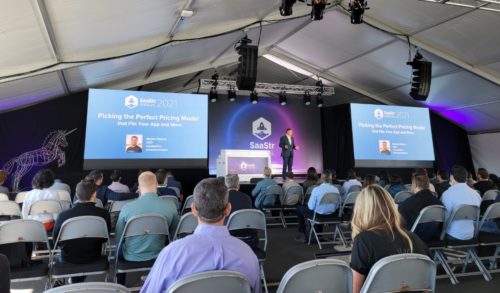With the rapid pace of the software-as-a-service (SaaS) industry, Viking Venture continuously seeks to stay up to date on the latest sector developments and benchmarks set by the ‘best-in-class’ SaaS companies. This ensures that we can provide informed advice and guidance to our portfolio companies about how to find and capitalize on opportunities, overcome challenges and succeed at scale.
Picture: Martin Senning Eriksen and Ingvild Farstad, respectively Investment Manger and Community & Marketing Manager, Viking Venture
By: Torstein Berteig, Investment Manager at Viking Venture
In this article you will find:
- A quick intro to the SaaStr Annual conference
- Key lessons learned at the conference
- Summaries from sessions we liked
SaaStr Annual 2021
Last week, we attended SaaStr Annual 2021 alongside approximately 5,000 of the best and brightest SaaS founders, executives and investors for a three-day in-person “festival-style” outdoor conference in San Mateo, California (with strict covid-19 protocols and vaccine requirements in place).
SaaStr Annual is the world’s largest community gathering for Cloud and SaaS professionals. With the exception of 2020, the top founders, VCs and senior executives in SaaS get together at SaaStr once a year to share their best practices and lessons learned. Both established industry titans and emerging leaders are represented, from well-known companies such as Box, Salesforce, Slack, Zoom and Atlassian to newer players such as Databricks, Flexport and HackerOne.
The three days of the conference centered around three different themes:
1. Masterminds of SaaS – advice from top practitioners in SaaS on “how to do it”
2. Legends of SaaS – thought leadership from leading SaaS CEOs
3. Money and Mentors – mentorship sessions and keynotes with prominent SaaS VCs
Key takeaways
Below are some of the main conclusions we took away from the conference:
- Growth continues to be the source of all good – however more focus on efficient growth (Net Retention / monetizing existing customers, Rule of 40, capital efficiency scores / ARR vs. capital deployed to get there)
- Make sure your sales model is functional and repeatable before you try to scale it. Too many companies try to hire large sales teams before they are ready, and end up having to scale back shortly thereafter. Nail your product market fit, find the right marketing/messaging, develop your sales playbook
- Use founder-led sales until your first 2-3 sales reps are (more than) covering their own cost, then move to a Sales-led selling model with a couple of additional sales reps, perhaps targeting a few more customer segments and geographies. Once this early sales organization covers 3-4x its own cost, you most likely have a scalable operation to hire additional sales reps into: Start with 2x new sales reps every other month and monitor your KPIs to ensure you can effectively ramp them up over time – scale recruiting from there
- Strive to find great additional offerings to sell – multi-product solution selling is very powerful: Customers buying several products have materially higher NRR and LTV than those with only one product/module
- Product-led growth (PLG) and its “frictionless selling” model is great, but be mindful that it is not suitable for every product / company / customer segment: You will still need sales for enterprise deals even if your product is suited for PLG (since Economic Buyers may not ever touch/use your product)
- Take care of your people, culture and organizational health as you scale – ultimately your product’s success come from your employees, your ability to maintain productivity and satisfaction is key
- Develop a well-functioning recruiting process and pipeline to ensure lack of people isn’t an issue for growth and organizational continuity
- Make sure everyone in the go-to-market organization has common end goals and (at least some) common KPIs to ensure Marketing and Sales are pulling in the same direction
- Understand which marketing channels provide high quality leads which lead to closed deals
- Continuously evaluate the leading factors for win/loss to enable sales reps to spend more time on the leads with the highest probability of ending in a successful deal
- Evaluate your pricing model: Chances are you have a lot of untapped potential to increase ARR through experimentation with different approaches to pricing, perhaps especially if your product lends itself well to consumption-based pricing
Session summaries from SaaStr Annual 2021
Below you will find our summary of the sessions we found particularly interesting, which we recommend checking out.
Summary of Bessemer Venture Partners’ State of the Cloud Session
Bessemer Venture Partners held a session discussing a mid-year update to their annual State of the Cloud Report, where they explore the major milestones and changes within the cloud economy and original analysis on the drivers of public and private cloud valuations. In the session (and the report) they shared new frameworks and strategies to help founders of emerging cloud companies measure growth endurance and drive go-to-market momentum. In addition, Bessemer Venture Partners discussed their seven predictions for the year ahead.
Overall, SaaStr Annual was a highly welcome return to in-person knowledge sharing and networking within our industry. Expanding our knowledge and understanding of the challenges and opportunities facing our industry via participation in events like SaaStr is important for the development of Viking Venture and our ability to continuously improve and add value to our portfolio companies and ultimately deliver returns to our investors.
Curious for more insights from Viking Venture?
Click on the link below, follow us on Linkedin and sign up for our newsletter.

